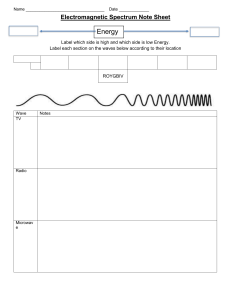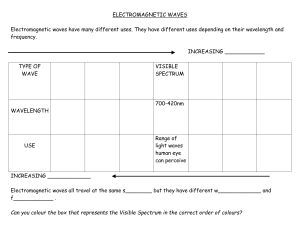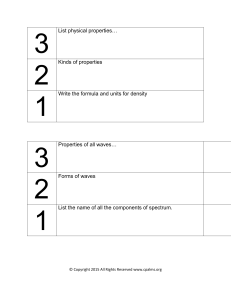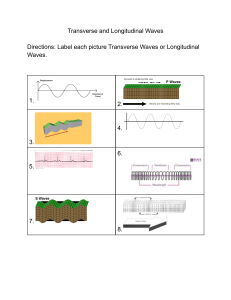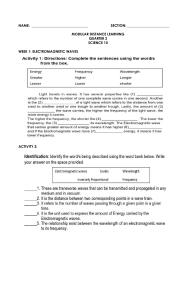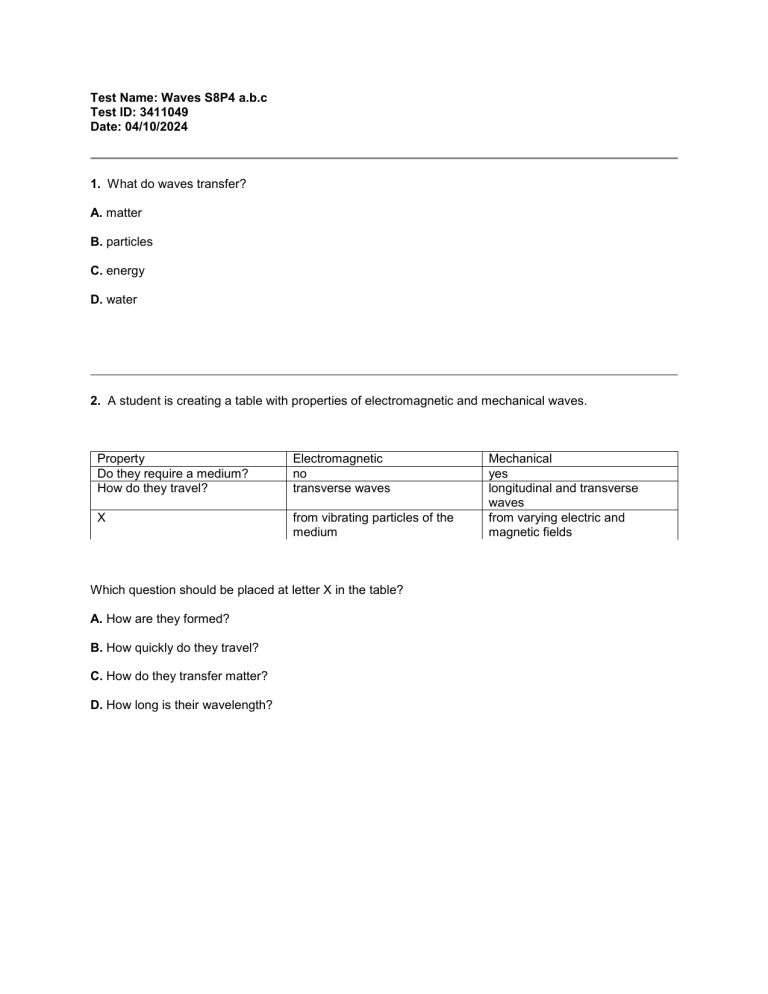
Test Name: Waves S8P4 a.b.c Test ID: 3411049 Date: 04/10/2024 1. What do waves transfer? A. matter B. particles C. energy D. water 2. A student is creating a table with properties of electromagnetic and mechanical waves. Property Do they require a medium? How do they travel? Electromagnetic no transverse waves X from vibrating particles of the medium Which question should be placed at letter X in the table? A. How are they formed? B. How quickly do they travel? C. How do they transfer matter? D. How long is their wavelength? Mechanical yes longitudinal and transverse waves from varying electric and magnetic fields 3. Which of the following statements is true with regard to transverse and longitudinal waves? A. Both transverse waves and longitudinal waves have motion parallel to velocity. B. Transverse waves have motion parallel to velocity, while longitudinal waves have motion perpendicular to velocity. C. Both transverse waves and longitudinal waves have motion perpendicular to velocity. D. Transverse waves have motion perpendicular to velocity, while longitudinal waves have motion parallel to velocity. 4. Mechanical waves A. require a high energy medium through which to travel. B. can only travel through a vacuum at high energies. C. require a physical medium through which to travel. D. can travel freely through the vacuum of space. 5. How are electromagnetic and mechanical waves similar? A. They both move matter. B. They both transfer energy. C. They both need a medium to travel. D. They both can travel through a vacuum. 6. The diagram below shows four waves. Which two waves have the same amplitude? A. W and Y B. Z and X C. Y and X D. W and X 7. Which of the following statements about electromagnetic and mechanical waves is true? A. Electromagnetic waves must travel through a medium, but mechanical waves do not require a medium. B. Electromagnetic waves travel mostly through matter, and mechanical waves travel mostly through a vacuum. C. Mechanical waves must travel through a medium, but electromagnetic waves do not require a medium. D. Mechanical waves sometimes travel through a vacuum, and electromagnetic waves sometimes travel through matter. 8. Look at the images below. Which image shows the shortest wavelength? A. W B. X C. Y D. Z 9. The picture shows a wave. Which describes the length of a wave? A. the distance between points V and X B. the distance between points V and Y C. the distance between points X and Y D. the distance between points W and X 10. The picture shows a wave. The distance between which points identifies the wave's amplitude? A. V and W B. V and X C. V and Y D. V and Z 11. A wave travels through a medium. As the wave passes, the particles of the medium vibrate in a direction perpendicular to the direction of the wave's motion. What kind of wave is this? A. electromagnetic B. longitudinal C. pulse D. transverse 12. What do radio waves, microwaves, X-rays, and gamma rays all have in common? A. They all have the same wavelength. B. They are electromagnetic waves. C. They are detected in the same way. D. They store the same amount of energy. 13. How do particles move in a longitudinal wave? A. The vibrations move perpendicular to the wave's direction of travel. B. The vibrations move in opposition to the wave's direction of travel. C. The vibrations move in circles along the wave's direction of travel. D. The vibrations move parallel to the wave's direction of travel. 14. Select three things that best determine the characteristics of a wave. A. crest B. distance C. wavelength D. trough E. amplitude F. frequency 15. Which of the following correctly lists electromagnetic waves in order from Greatest to Least energy levels? A. Radio, Infrared, Ultraviolet, X-ray B. Microwave, Ultraviolet, Visible, X-ray C. Ultraviolet, Infrared, Radio, Microwave D. X-ray, Visible, Microwave, Radio 16. Which of the following types of electromagnetic radiation, ultraviolet or infrared, has the highest amount of energy and how do you know? A. Infrared, because it has a longer wavelength B. Infrared, because it has the higher frequency C. Ultraviolet, because it has the longer wavelength D. Ultraviolet, because it has the higher frequency 17. Which of the following electromagnetic waves has the shortest wavelength? A. microwave B. ultraviolet C. X-ray D. light 18. Which of the following shows the correct order of the electromagnetic spectrum, from shortest wavelength to longest? A. gamma ray → X-ray → ultraviolet → visible → infrared → microwave → radio B. radio → microwave → infrared → visible → ultraviolet → X-ray → gamma ray C. visible → infrared → ultraviolet → X-ray → gamma ray → radio → microwave D. microwave → X-ray → gamma ray → ultraviolet → visible → radio → infrared 19. The diagram below is of the electromagnetic spectrum. Which feature best distinguishes one form of electromagnetic energy from another? A. color B. wavelength C. distance traveled D. surface temperature 20. Visible light is only a portion of light found on the electromagnetic spectrum. Which of the following shows the order of visible light from the light with shortest wavelength to the longest wavelength? A. violet, indigo, blue, green, yellow, orange, red B. red, orange, yellow, green, blue, indigo, violet C. blue, violet, indigo, green, red, orange, yellow D. orange, red, yellow, indigo, violet, blue, green 21. A scientist is designing a medical device that will produce an image of a bone, but not the surrounding tissues. Which type of wave from the electromagnetic spectrum would best complete the scientist's design and why? A. X-ray waves would be the best choice because they have long wavelengths. B. X-ray waves would be the best choice because they have short wavelengths. C. Infrared waves would be the best choice because they have small amplitudes. D. Infrared waves would be the best choice because they have large amplitudes. 22. If a scientist is designing a device to create high energy electromagnetic waves, which type of wave would the device most likely create? A. microwaves B. infrared waves C. ultraviolet waves D. gamma ray waves 23. A scientist is designing a device that will kill harmful cells in the human body using high-energy waves. Which type of wave would be most effective in accomplishing this goal? A. X-rays would be the best choice because they have a long wavelength and a low frequency. B. Radio waves would be the best choice because they have a long wavelength and a low frequency. C. Gamma rays would be the best choice because they have a short wavelength and a high frequency. D. Infrared waves would be the best choice because they have a short wavelength and a high frequency. 24. Airport security uses electromagnetic waves to see items inside of luggage without having to open the bags. Which type of electromagnetic waves would be best for airport security to use? A. X-rays would be best because they are low-energy waves that can penetrate gases. B. X-rays would be best because they are high-energy waves that can penetrate solids. C. Radar waves would be best because they are low-energy waves that can penetrate gases. D. Radar waves would be best because they are high-energy waves that can penetrate solids. 25. Dillon wonders if he can block the radio waves released by the remote control used to operate his radio-controlled car. He covers the remote control in different materials and tries to use it to operate his car. He records his observations in the table below. Materials cotton aluminum foil plastic wrap wax paper Observations remote control works remote control does not work remote control works remote control works Why does the remote control not work when covered with aluminum foil? A. because the aluminum foil blocks the batteries B. because the aluminum foil blocks the microwaves C. because the aluminum foil blocks the radio waves D. because the aluminum foil blocks the sound waves You have reached the end of this section.

